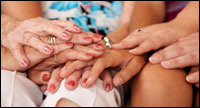Support Women's Health
 National Women's Health Week begins on Mother's Day each year. Take steps to improve women's health in yourself, your family, and your community.
National Women's Health Week begins on Mother's Day each year. Take steps to improve women's health in yourself, your family, and your community.
 Addressing issues that impact the health and safety of women can be done in a variety of ways that benefit individuals, families, communities, and beyond. Developing a new program at work, providing services in the community, being a great role model, or sponsoring an activity within your organization are only a few of the many ways to take action.
Addressing issues that impact the health and safety of women can be done in a variety of ways that benefit individuals, families, communities, and beyond. Developing a new program at work, providing services in the community, being a great role model, or sponsoring an activity within your organization are only a few of the many ways to take action.
Improving women's health is not limited to the doctor's office or hospital. Improving women's health starts at home with individuals and families taking steps to live safer and healthier lives. It also starts with communities, businesses, and others establishing and supporting programs and policies that focus on health.
Learn More about Women's Health
- Listen to a women's health podcast on a variety of topics, including:
- Chlamydia and Women (
 2:52 mins)
2:52 mins) - Diabetes and Depression in Older Women (
 4:09 mins)
4:09 mins) - Gestational Diabetes and Women (
 4:09 mins)
4:09 mins) - Heart Disease and Stroke in Women (
 3:54 mins)
3:54 mins) - Obesity and Women (
 3:57 mins)
3:57 mins) - Oral Health and Women (
 5:02 mins)
5:02 mins) - Teen Pregnancy in the United States (
 2:37 mins)
2:37 mins) - Workplace Safety and Women (
 2:52 mins)
2:52 mins)
- Chlamydia and Women (
- Visit the CDC Women's Health Web site.
Send a Women's Health-e-Card
- Send a women's health-e-card to show someone you care about their health and safety.
Help Support Women's Health
 Support National Women's Health Week, which starts on Mother's Day each year. Sponsor a health fair or fitness walk. Provide information about programs, services, or issues related to women's health. Help raise awareness about issues impacting women's health and safety.
Support National Women's Health Week, which starts on Mother's Day each year. Sponsor a health fair or fitness walk. Provide information about programs, services, or issues related to women's health. Help raise awareness about issues impacting women's health and safety.- Know what community and other resources are available that support and provide care for women. National and local hotlines on a variety of issues are available to provide information and locations for services. Breast and cervical cancer screenings for uninsured or underinsured women are available through the National Breast and Cervical Cancer Early Detection Program. Health services for individuals with no or low health coverage are available through federally-funded health centers, where the fee is based on what the individual can pay. CDC information is available at 1-800-CDC-INFO (232-4636).
- Identify needs in your community, and determine what your program or organization can do. Data on women's health, youth risk behavior, and general health is available from a variety of local, state, and national organizations and agencies, including CDC.
- Identify opportunities in your workplace to improve women's health and general health. Learn what issues impact women's health while on the job. Create sexual harassment prevention policies at work, school, and other places. Establish a breastfeeding program. Serve healthier meals and snacks.
- Lower physical, social, and environmental barriers to health care for persons with disabilities. As many as one in five women in the United States are living with disabilities. Women are more frequently affected by many of the conditions that cause disability, and well over half of all women older than 65 are living with a disability.
- Help raise awareness of the five main types of gynecologic cancer: cervical, ovarian, uterine, vaginal, and vulvar. When gynecologic cancers are found early, treatment is most effective. Gynecologic cancers do have warning signs.
- Develop a fall prevention program to reduce falls among older adults. Among older adults, falls are the leading cause of injury deaths. In 2003, about 72% of older adults admitted to the hospital for hip fractures were women.
Help Keep Girls Safe and Healthy
 Teach adolescent girls and boys to "choose respect." Help young people learn the skills to form positive, healthy relationships and prevent abusive relationships.
Teach adolescent girls and boys to "choose respect." Help young people learn the skills to form positive, healthy relationships and prevent abusive relationships.- Stay up-to-date on pre-teen vaccines, including HPV vaccine for girls. HPV vaccine protects against the types of HPV that most commonly cause cervical cancer and genital warts.
- Encourage kids to be active at least one hour each day. Include activities that raise breathing and heart rates and that strengthen muscles and bones.
- Wear seatbelts and helmets to prevent injury (
 1MB, 2 pages). Properly restrain all children ages 12 or younger in the back seat. Wear helmets when riding bicycles and motorcycles.
1MB, 2 pages). Properly restrain all children ages 12 or younger in the back seat. Wear helmets when riding bicycles and motorcycles.
More Information
Current Features
Need info on a
different topic? See





